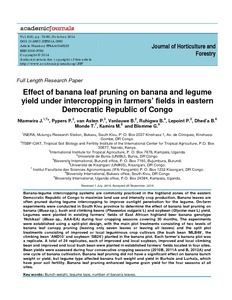Resource information
Banana-legume intercropping systems are commonly practiced in the highland zones of the eastern Democratic Republic of Congo to maximize land use and intensify crop production. However, banana leaves are pruned during legume intercropping to improve sunlight penetration for the legume. On-farm experiments were conducted in South Kivu province to determine the effect of banana leaf pruning on banana (Musa sp.), bush and climbing beans (Phaseolus vulgaris L) and soybean (Glycine max L) yield. Legumes were planted in existing farmers’ fields of East African highland beer banana genotype ‘Nshikazi’ (Musa sp., AAA-EA) during four cropping seasons covering 30 months. The experiments were established using a split-plot design, with the main plot treatments consisting of two levels of banana leaf canopy pruning (leaving only seven leaves or leaving all leaves) and the split plot treatments consisting of improved or local leguminous crop cultivars (the bush bean ‘MLB49’, the climbing bean ‘AND10’ and soybean ‘SB24’ planted in the banana plot. Each farmer’s banana plot was a replicate). A total of 24 replicates, each of improved and local soybean, improved and local climbing bean and improved and local bush bean were planted in established farmers’ fields located in four sites. Bean yields were assessed during four consecutive cropping seasons (2010B, 2011A and B, 2012A) and one cycle of banana cultivation. Banana leaf pruning did not have a significant effect on banana bunch weight or yield, but legume type affected banana fruit weight and yield in Burhale and Lurhala, which have poor soil fertility. Banana leaf pruning enhanced legume grain yield for the four seasons at all sites.



